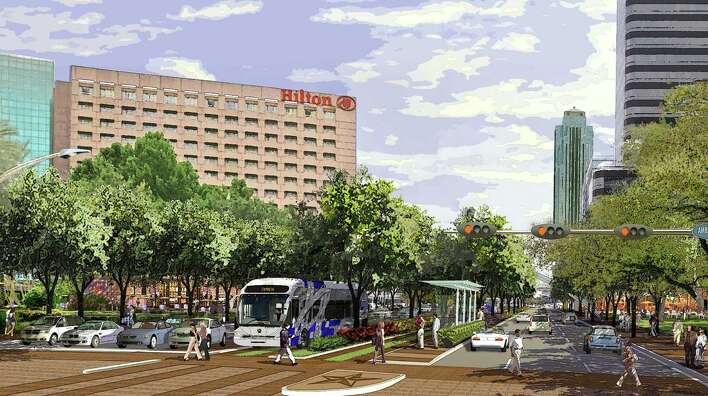Most discussion of the Uptown Tax Increment Reinvestment Zone’s plan, which goes before City Council this week, has been about a proposal to annex Memorial Park into the zone and spend $100 million restoring the drought-stricken park. The centerpiece of the zone’s plan, however, is a $187.5 million vision to widen and rebuild Post Oak Boulevard with dedicated bus lanes in the middle, build 7,500 feet of elevated bus lanes on the West Loop, and finance a transit center and parking garage at Westpark and the West Loop.
“We’re doing a lot to improve streets in the Uptown area to help make it more convenient for people to get around, but getting to the Uptown area, we’ve done about all we can with the automobile,” said John Breeding, director of the Uptown zone. “What we need to do is find some way to grow our transportation supply, and that is by bringing in transit.”
Breeding stressed that Post Oak’s existing six lanes and protected left turn lanes would be preserved.
More than 65 percent of Uptown workers live to the southwest and northwest in areas served by HOV lanes and Metro’s park and ride service, Breeding said, but just 10 of 300 daily park and ride buses visit the Galleria; most go downtown.
“We are badly underserved right now,” said Kendall Miller, an Uptown zone board member. “We have some local routes that kind of go through us, we have some van pools that are organized by the big companies. It’s very ad lib.”
About 37 percent of all downtown workers take a Metro vehicle to work, Breeding said, and 62 percent of them make more than $80,000 a year, showing people choose transit for many reasons and that everyone from oil executives to retail clerks would use the buses if they served Uptown.
[…]
Metro board member Christof Spieler said about half the people who live in areas served by park and rides use the service, adding that Metro has long wanted to add Uptown to that list.
“It’s never been possible because, in order to get from the Northwest Transit Center or the Southwest Freeway to Uptown, those buses would have wound up stuck in same traffic with everyone else,” he said. “I really think this is a game-changer for transit in one of our most important job centers.”
City Councilman Oliver Pennington, who represents the area, said Greater Houston Partnership data show there are almost 200,000 jobs in his district, 91 percent of which are filled by workers living elsewhere, creating “a terrific traffic nightmare.” The proposed transit plan would make the area more competitive and more livable, he said.
“I’m a firm believer that we need some things to show what a great city we are. I think it will not only serve the people, but it will show the world that Houston is doing things for its citizens. We need some physical evidence of the kind of life that we enjoy here.”
See here, here, here, and here for the background. I think this is the first mention I’ve seen of elevated bus lanes for the West Loop, which would enable the park and ride buses to avoid the traffic of the Loop and thus be more attractive to potential riders. It certainly makes sense to expand the park and ride network into Uptown, and I do think it will be heavily used once that happens. Having the support of CM Pennington makes approval of the TIRZ expansion very likely, though I’m sure there will be some lively discussion given the Memorial Park concerns that have been raised.
Expansion of the TIRZ is still a necessary condition for any of this to go forward. Funding for this plan is dependent in part on a grant from the Houston-Galveston Area Council Transportation Policy Council, which has not yet approved said funding but could take the matter up once soon.
The proposals could come for consideration before the regional group’s Transportation Policy Council – the body responsible for allocating the federal grants – on May 24 or June 28, said Alan Clark, H-GAC’s transportation director.
“The council allocated around $400 million in grants at its April 26 meeting. The projects in question were not slated for action, but money was held back so these projects can be considered,” Clark said.
Before the proposals go for a TPC vote, an H-GAC advisory committee will consult with the Texas Department of Transportation about one phase of the plan that would involve linking bus service on Post Oak to Metro’s Northwest Transit Center, Clark said.
Current ideas include creating a grade-separated bus way above the main lanes of Loop 610 that would be connected to a Post Oak transit line, he said.
“Because this (the connection between Post Oak and the Northwest Transit Center) is so integral to the overall plan and its anticipated benefits, the Technical Advisory Committee wants to do further study,” Clark said.
Again, I feel confident that this will go through, but it’s fine if H-GAC wants to take its time and think about it some.
One other point to stress about all this is that by extending Metro’s park and ride network into Uptown, which includes the BRT lanes on Post Oak, we are also building for even more expansion and connections in the future. The Westpark transit center would obviously be of use when the University line finally gets built. If there is ever a commuter rail line along US 290, the Northwest transit center, which is the northern endpoint of this project, would be the gateway from it into Uptown. Adding a node to a network has value beyond the node itself. This plan has a lot to offer for Uptown, but it’s potentially very good for the big picture as well.


Pingback: Uptown transit plan gets key funding approval – Off the Kuff